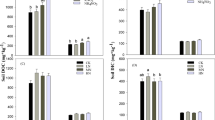Abstract
Main objective of this study was to test the effects of Mg(OH)2-fertilization in a Norway spruce ecosystem showing severe symptoms of Mg-deficiency.
The site is characterized by high atmospheric inputs with deposition rates of 1.25 kg H, 42 kg S, and 32 kg N per ha and year. The typic Dystrochrept derived from granite is acidified down to greater depths. The pH-values in soil solution of the organic surface layer and the upper mineral soil are around 3.5. Concentrations of Al, SO4 2-, and especially NO3 - and DOC are very high. The element balance indicates a significant influence of N-inputs and processes of N-turnover on the chemical status of the soil and probably on tree nutrition. Nitrification in the upper mineral soil leads to a transformation of a major part of NH4 + into NO3 -, which is quantitatively leached, resulting in an ecosystem-internal H+-production of 1.8 keq ha-1yr-1. NO3 - and SO4 2- govern the seepage output from the ecosystem.
Mg(OH)2 fertilization resulted in manifold increased Mg2+ concentrations in soil solution down to 70 cm soil depth and to a significant increase of pH down to 25 cm mineral soil depth. Nitrate concentrations were elevated after fertilization, but decreased within 15 months below the level of the control plot. As a mean over the whole experimental period, N-output was not increased by fertilization. Despite an elevated internal proton production due to nitrification, acid buffering in the soil was clearly increased, but enhanced Al-mobilization was not observed. Mg/Al- and Ca/H-ratios in soil solution indicate much more favourable conditions for fine root growth. Fertilization also increased the amount of exchangeable Mg down to 40cm mineral soil depth. Mg contents in current-year needles increased after three vegetation periods. Thirty months after application, only 10% and 4% of the fertilized Mg had left the organic surface layer and the mineral soil with seepage water output, respectively.
Similar content being viewed by others
References
AG Bodenkunde 1982 Bodenkundliche Kartieranleitung. Hannover. 331p.
Feger K H, Zöttl H W and Brahmer G 1991 Assesment of the ecological effects of forest fertilization using an experimental watershed approach. Fert. Res. 27, 49–61.
Hanisch B 1989 IMA-Querschnittseminar: Düngung geschädigter Waldbestände. KfK-PEF Bericht 55, Kernforschungszentrum Karlsruhe. 343p.
Hantschel R 1987 Wasser— und Elementbilanz von geschädigten, gedüngten Fichtenökosystemen im Fichtelgebirge unter besonderer Berücksichtigung der physikalischen und chemischen Bodenheterogenität. Bayreuther Bodenkundl. Ber. 3. 219p.
Hildebrand E E 1990 Der Einfluß von Forstdüngungen auf die Lösungsfracht des Makroporenwassers. Allgem. Forstz. 24, 604–607.
Huettl R F 1988 “New type” forest decline and restabilization/revitalization strategies—A programmatic focus. Water Air Soil Pollut. 41, 95–111.
Huettl R F 1991 Die Nährelementversorgung geschädigter Wälder in Europa und Nordamerika. Freiburger Bodenkundl. Abh. 28. 440p.
Huettl R F and Zoettl H W 1993 Liming as a mitigation tool in Germany's declining forests—reviewing results from former and recent trials. For. Ecol. Manage. 61, 325–338.
Kaupenjohann M 1989 Chemischer Bodenzustand und Nährelementversorgung NO-Bayerischer Fichtenbestnde. Bayreuther Bodenkundl. Ber. 9. 202p.
Kaupenjohann M und Zech W 1989 Waldschäden und Düngung. Allgem. Forstz 37, 1002–1008.
Kaupenjohann M 1991 Magnesium-Mangel im Wald. Kali-Briefe (Büntehof) 20, 561–577.
Kreutzer K 1986 Zusammenfassende Diskussion der Ergebnisse aus experimentellen FreilandUntersuchungen über den Einflub von sauren Niederschlägen und Kalkung in Fichtenbeständen. (Picea abies (L.) Karst.). Forstwiss. Centralbl. 105, 371–379.
Liu J C 1988 Ernährungskundliche Auswertung von diagnostischen Düngungsversuchen in Fichtenbeständen (Picea abies Karst.) Südwestdeutschlands. Freiburger Bodenkundl. Abh. 21. 193p.
Liu J C und Ende H P 1989 Wirkungen von Nitrat— und Sulfatdüngern auf Boden-pH und Nährelementversorgung von Fichten— und Buchenbeständen. Kernforschungszentrum Karlsruhe, kfk-PEF Bericht 55, 323–336.
Marschner B 1990 Elementumsätze in einem Kiefernforstökosystem auf Rostbraunerde unter dem Einflußeiner Kalkung/Düngung, Ber. Forschungsz Waldökosysteme A60, 1–192.
Marschner B, Stahr K and Renger M 1988 Potential hazards of lime application in a damaged pine forest ecosystem in Berlin, Germany. Water Air Soil Pollut. 41, 45–57.
Oren R and Schulze E-D 1989 Nutritional disharmony and forest decline: a conceptual model. In Forest Decline and Air Pollution. Eds. E-DSchulze, O LLange and ROren. pp 425–443. Ecological Studies Vol. 77. Springer, Berlin.
Rehfuess K E 1989 Möglichkeiten und Grenzen von Düngungs- und Meliorationskalkung (als Mabnahmen) gegen “neuartige” Waldschäden. In Internationaler Kongress Waldschadensforschung: Wissensstand und Perspektiven. Ed. B Ulrich. Vol. 1, pp 753–778. Friedrichshafen, 2–6.10.1989.
Sauter U 1989 Düngung zur Vitalisierung neuartig geschädigter Waldbestände in Bayern. Kali-Briefe (Büntehof) 19 (6),443–459.
Schaaf W 1992 Elementbilanz eines stark geschädigten Fichtenökosystems und deren Beeinflussung durch neuartige basische Magnesiumdünger. Bayreuther Bodenkundl. Ber. 23, 169p.
Schaaf W and Zech W 1991 Einflub unterschiedlicher Löslichkeit von Dngern. Allg. Forstz. 15, 766–768.
Türk T 1992 Die Untersuchung der Wasser— und Stoffdynamik in zwei unterschiedlich geschädigten, bewaldeten Einzugsgebieten im Fichtelgebirge. Bayreuther Bodenkundl. Ber. 22, 203p.
Ulrich B 1983 Interactions of forest canopies with atmospheric constitutents: SO2, alkali and earth alkali cations and chloride. In Effects of Accumulation of Air Pollutants in Forest Ecosystems. Eds. BUlrich and J Pankrath. pp33–45. D. Reidel Publishing Company, Dordrecht, The Netherlands.
Wenzel B 1989 Kalkungs— und Meliorationsexperimente im Solling: Initialeffekte auf Boden, Sickerwasser und Vegetation. Ber. Forschungszentrum Waldökosysteme A51, 1–274.
Zech W und Popp E 1983 Magnesiummangel, einer der Gründe für das Fichten— und Tannensterben in NO-Bayern. Forstwiss. Centralbl. 102, 50–55.
Zoettl H W 1990 Ernährung und Düngung der Fichte. Forstwiss. Centralbl. 109, 130–137.
Author information
Authors and Affiliations
Rights and permissions
About this article
Cite this article
Schaaf, W. Effects of Mg(OH)2-fertilization on nutrient cycling in a heavily damaged Norway spruce ecosystem (NE Bavaria/FRG). Plant Soil 168, 505–511 (1995). https://doi.org/10.1007/BF00029363
Issue Date:
DOI: https://doi.org/10.1007/BF00029363




